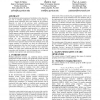JLP
2011
14 years 1 months ago
2011
Formal languages for policy have been developed for access control and conformance checking. In this paper, we describe a formalism that combines features that have been developed...
ICTAI
2010
IEEE
14 years 3 months ago
2010
IEEE
Planning techniques recorded a significant progress during recent years. However, many planning problems remain still hard even for modern planners. One of the most promising appro...
ICDE
2009
IEEE
14 years 4 months ago
2009
IEEE
The identification and processing of similarities in the data play a key role in multiple application scenarios. Several types of similarity-aware operations have been studied in ...
HCI
2009
14 years 4 months ago
2009
Task time is a measure of productivity in an interface. Keystroke Level Modeling (KLM) can predict experienced user task time to within 10 to 30% of actual times. One of the bigges...
ICFEM
2010
Springer
14 years 4 months ago
2010
Springer
Design patterns are rarely used on their own. They are almost always to be found composed with each other in real applications. So it is crucial that we can reason about their comp...
GLOBECOM
2010
IEEE
14 years 4 months ago
2010
IEEE
The telecommunication world keeps evolving, with the development of new technologies, and operators have to wonder if investing in the costly infrastructures and potential licenses...
LPAR
2010
Springer
14 years 5 months ago
2010
Springer
We address the problem of merging qualitative constraint networks (QCNs) representing agents local preferences or beliefs on the relative position of spatial or temporal entities. ...
KSEM
2010
Springer
14 years 5 months ago
2010
Springer
Abstract. In this paper, we compare merging operators in possibilistic logic. We first propose an approach to evaluating the discriminating power of a merging operator. After that...
IGPL
2010
14 years 5 months ago
2010
Communication between natural or artificial agents relies on the use of a common vocabulary. Since sharing terms does not necessarily imply that the terms have exactly the same m...
PVLDB
2008
14 years 6 months ago
2008
Many stream-processing systems enforce an order on data streams during query evaluation to help unblock blocking operators and purge state from stateful operators. Such in-order p...


